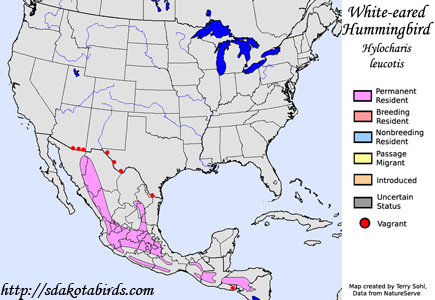| Length: 3.75 inches | Wingspan: 5.75 inches | Seasonality: Non-resident in South Dakota |
| ID Keys: Obvious white stripe behind eye, short reddish bill with black tip, green upperparts, males deep purple throat and crown | ||
 The
White-eared Hummingbird is a hummingbird of Mexico and central America, with
occasional strays to southern Arizona, southern New Mexico, and west Texas.
Vagrants have also occurred at scattered other locations in the United
States. White-eared Hummingbirds seem to tolerate each other's
presence more than many hummingbirds, with prime nesting locations often
holding multiple nests in relatively close proximity.
The
White-eared Hummingbird is a hummingbird of Mexico and central America, with
occasional strays to southern Arizona, southern New Mexico, and west Texas.
Vagrants have also occurred at scattered other locations in the United
States. White-eared Hummingbirds seem to tolerate each other's
presence more than many hummingbirds, with prime nesting locations often
holding multiple nests in relatively close proximity.
Habitat: White-eared Hummingbirds are typically found in pine and pine-oak forests in their Mexican and Central American range. Those found in the United States are typically found in wooded riparian zones in canyons.
Diet: Typical diet of hummingbirds, primarily nectar, but insects also comprise a portion of the diet.
Behavior: White-eared Hummingbirds are subordinate to many other species, and often don't establish and defend feeding territories. While nests can occur in close proximity to each other, at other times of the year, they are mostly solitary.
Nesting: Females alone build the nest, using plant fibers and spider webs, and camouflaging the outside with lichens. The female also incubates the eggs and raises the young.
Song: Males' song composed of a series of high chip with choppy rattling interspersed. Calls during chase are five crisp chip calls in rapid succession.
Migration: White-eared Hummingbirds are generally permanent residents throughout their range. Local movements are made in accordance with availability of preferred flowering plants, but true migration is typically not observed with the species. However, birds found in the United States are typically only found during the summer months, and some birds in the far northern part of their Mexican range may move short distances south in the fall.
Interactive eBird map: Click here to access an interactive eBird map of White-eared Hummingbird sightings
Feeders: Will attend hummingbird feeders, and is one of the most common feeder hummingbirds in much of Mexico.
Similar Species: Extremely similar to Xantu's Hummingbird. They are also similar in structure and basic plumage to the Broad-billed Hummingbird.
Conservation Status: No conservation concerns are presently noted for the species
Further Information: 1) Cornell's Neotropical Birds - White-eared Hummingbird
2) WestTexasHummingbirds.com - White-eared Hummingbird
3) AvianWeb - White-eared Hummingbird
Image Information: Colored pencil drawing by Terry Sohl
Additional Photos: Additional Photos Coming Soon!!
| Click below for a higher-resolution map |
 |
| South Dakota Status: Non-resident in South Dakota |
Additional White-eared Hummingbird Photos

